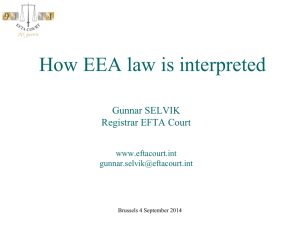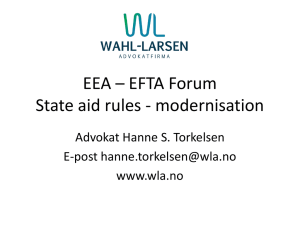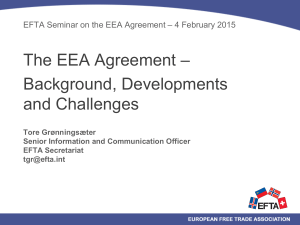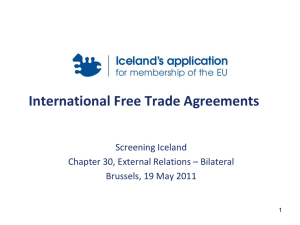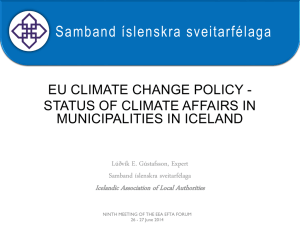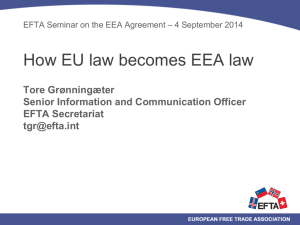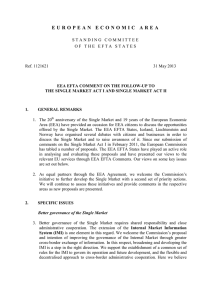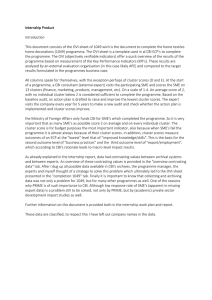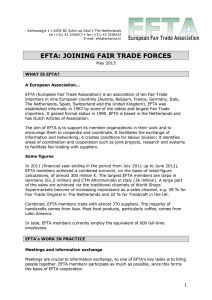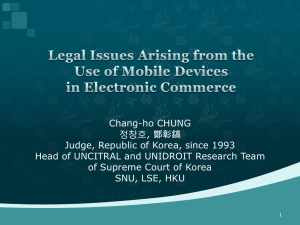How EEA law is interprested (Gunnar Selvik, EFTA Court)
advertisement
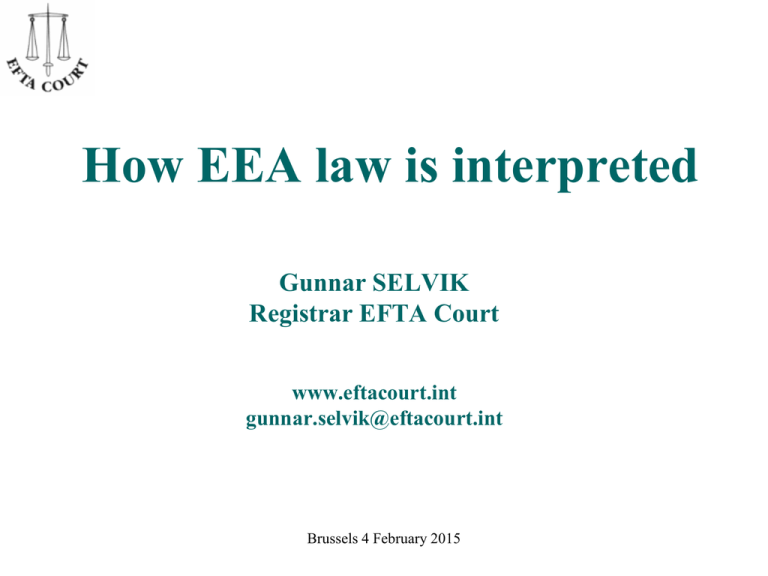
How EEA law is interpreted Gunnar SELVIK Registrar EFTA Court www.eftacourt.int gunnar.selvik@eftacourt.int Brussels 4 February 2015 General points Established as a part of the EEA cooperation the judicial function Independent international Court with clearly defined competences Seated in Luxembourg Two pillars – one agreement The EFTA Court interprets the EEA agreement in the EFTA states The EU Courts interpret the EEA agreement in the EU states THE TWO PILLAR STRUCTURE UNDER THE EEA AGREEMENT ICELAND LIECHTENSTEIN NORWAY EEA COUNCIL Ministers of EU and EFTA EEA states EU COUNCIL EFTA STANDING COMMITTEE* EEA JOINT COMMITTEE EEAS+EUROPEAN COMMISSION EFTA Secretariat EEAS, Commission and EU and EFTA government representatives Commission Services EFTA SURVEILLANCE AUTHORITY EU COURTS EFTA COURT COMMITTEE OF MPs OF THE EFTA STATES EFTA Secretariat EFTA CONSULTATIVE COMMITTEE EFTA Secretariat * Switzerland has observer status EEA JOINT PARLIAMENTARY COMMITTEE * EUROPEAN PARLIAMENT MPs from the EFTA parliaments and MEPs EP Secretariat EEA CONSULTATIVE COMMITTEE* EUROPEAN ECONOMIC AND SOCIAL COMMITTEE (EESC) EESC Secretariat Legal basis EEA agreement article 108(2): provides that the EFTA States shall establish the EFTA Court Surveillance and Court Agreement (SCA) article 27: the legal basis for the establishment of the EFTA Court Protocol 5 SCA: Statutes Rules of Procedure Instructions to the Registrar Organisation 3 judges → Each EFTA state nominates one judge One cabinet per judge, legal secretaries and personal assistants Registrar responsible for procedural questions and for the administration of the Court No Advocate General, no General Court (≠ ECJ) Guest office for researchers etc. Total staff: 18 + trainees Organigram Mr Carl BAUDENBACHER Judge/President CH Mr Páll HREINSSON Judge ICE Mr Per CHRISTIANSEN Judge NOR Mr Philipp SPEITLER Legal Secretary GER Mr Kjartan BJÖRGVINSSON Legal Secretary ICE Mr Jørgen REINHOLDTSEN Legal Secretary NOR Mr Michael James CLIFTON Legal Secretary (temp) UK Ms Kerstin Schwiesow Personal Assistant GER Ms Hrafnhildur EYJÓLFSDÓTTIR Personal Assistant ICE Ms Silje NÆSHEIM Personal Assistant NOR Mr Salim GUETTAF Man. premises FRA Mr Gunnar SELVIK Registrar NOR Ms Bryndis Ms Giulia Ms Harriet PALMARSDÓTTIR PREDONZANI BRUHN Research Lawyer Sen. Adm.&Fin.Off. Transl./Adm.Officer ICE (temp) ITA NOR Ms Mary COX, Info/Comm Coord UK Mr Tomasz Mazur Adm.&Fin. Officer (temp) POL Ms Sharon WORTELBOER Adm. Assistant UK/LUX Types of cases - I DIRECT ACTIONS (DA) • Infringement actions vs. EFTA States: - Initiated by ESA (art 31 SCA) - Initiated by another EFTA State (art 32 SCA) • Infringement actions vs. ESA: - Validity of ESA’s decisions (art 36 SCA) - ESA’s failure to act (art 37 SCA) - Liability of ESA (art 39 SCA) • Parties: ESA, EFTA States and in some cases private entities Types of cases - II ADVISORY OPINIONS (AO) • Who can request? - ”..any court or tribunal in an EFTA-State..” (Art 34(2) SCA) • When request? - ”Where... that court or tribunal considers it necessary to enable it to give judgment..” (Art 34(2) SCA) • Effect? - Always followed, but formally speaking not binding (≠ ECJ’s preliminary rulings) - National courts’ incorrect interpretation of the EEA agreement is in principle a breach of treaty obligations Procedure Main focus on written procedure Usually followed by an oral hearing Right to make written observations and to participate in the oral hearing: EFTA states, EU states, ESA, Commission and also private parties (if legal standing) Relationship EU Courts - EFTA Court Article 105(2,3) EEA – formal equality Art. 6 EEA and Art. 3 SCA: EEA to be interpreted in conformity with the relevant case law of the ECJ EFTA Court following the ECJ EFTA Court goes first EFTA Court rulings on EEA specific problems Statistics (case load) - I Increase of new cases in recent years: Total 1994–2015: 227 cases (57% DA/43% AO) Annual average: First 15 years: Last 6 years: ”Low point”: ”High point”: 2014: 2015 so far: ≈ 11 cases 107 cases (7/year) 120 cases (20/year) 2 cases (1999) 30 cases (2013) 25 cases (83% DA/17% AO) 4 cases (4 DA/1AO) Statistics (case load) - II Trends: Direct Actions: Surge in non-implementations (especially against Iceland), state aid, access to documents... Advisory Opinions: Norway underrepresented, aftermath of financial crisis, increased complexity... Maintain effective case handling time: 6-8 months (ECJ: 22-24 months) Statistics (case load) - III Pending cases: Total 12: → 10 Direct Actions (state aid/access documents/work as dentist/non-implementations/regionally differentiated social security contributions) → 2 Advisory Opinions (medicinal products, environmental impact assessments in building projects) Statistics (case load) - III Pending cases Total 13: → 12 Direct Actions (state aid/access documents/work as dentist/non-implementation/regionally differentiated social security contributions) → 1 Advisory Opinion (medicinal products) WWW.EFTACOURT.INT Court Diary Composition of the Court Legal Sources regarding the Court Decided and Pending Cases Yearly Reports of the Court as from 2004 Contact Info: eftacourt@eftacourt.int Advisory Opinions – 1994 - 2015 97 Advisory Opinions - per country 5 29 18 Icelandic Courts Norwegian Courts Liechtenstein Courts Others 45 1, rue du Fort Thüngen, L-1499 Luxembourg 5 www.eftacourt.int Direct Actions – 1994 - 2015 130 Direct Actions - divided by applicant 16 51 22 Against ESA ESA v Iceland ESA v Norway ESA v Liechtenstein 41 1, rue du Fort Thüngen, L-1499 Luxembourg 3 www.eftacourt.int
